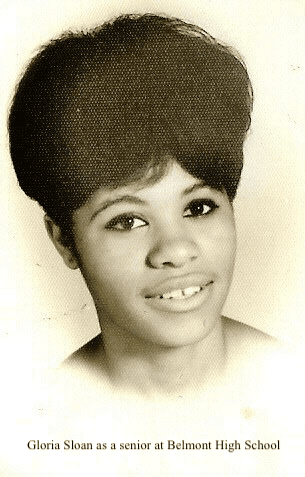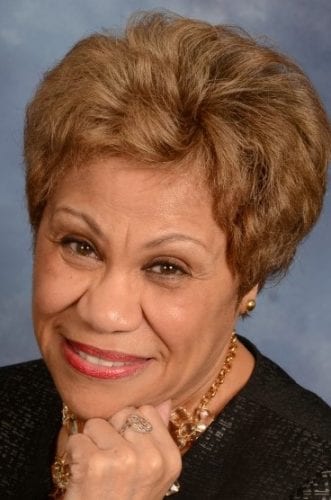
Implementing Brown v. Board of Education: One Southern Town’s Story (Pt. 2)
Part II: Teenaged Integration Pioneers Endure a Lonely Spotlight

Gloria Reeves Sloan was the oldest of the first three students to integrate Belmont High School. Entering Belmont High as a junior, she would be the first African American to graduate from the high school. Today, Sloan is founder and president of Personal Dynamics, Inc., a global hospitality consulting firm. In 2018 she published a memoir, Abundant Faith, Secrets to Plenty: Traveling on Life’s Journey (Westbow Press). In it she details the spiritual practices that enabled her to turn challenging life experiences, including her years as an integration pioneer, into opportunities for growth and achievement. You can read more about her at gloriasloan.com.
(For more about the implementation of the Brown decision nationwide, see James T. Patterson, Brown v. Board of Education: A Civil Rights Milestone and Its Troubled Legacy [New York: Oxford University Press, 2001], 86-223.)
Below, Sloan shares her experience of school integration in Belmont with TAH Publications Editor Ellen Deitz Tucker.
You entered Belmont High School in September of 1964, as the sole black student in the junior class. The same year, two other black female students were enrolled in the sophomore class. Would you explain how the responsibility of leading the integration of Belmont High School fell on the three of you?
I will speak only for myself; I’m sure the other two black students have their own thoughts and feelings on the subject. I recall the adults speaking of what we were doing as “pioneering to integrate.” Our fathers, along with other leaders in our church, had attended a meeting in neighboring Mecklenburg County at which the Reverend Martin Luther King and other members of the Southern Christian Leadership Council spoke. Their message was: It is time to get school integration done! Later, this cause was discussed at our church. I don’t recall exactly what was said, but I’m sure we had a voice in the matter. It was presented to us not as an assignment, but as an opportunity to help the community achieve an important goal. People have often asked, how were we selected? I simply say that we attended the same church. Those working behind the scenes to plan the integration process probably know why we were asked to do this.

Yet there must have been something about your character or upbringing that made church leaders feel you could handle their request.
I was the last child of six, more than a decade younger than my older siblings, and my mother died when I was small. My father raised me by himself while he worked three jobs. He was a machinist at one of the local mills, the proprietor of a small store, a cook, and a handyman. My father raised me well on his own with support from family and neighbors. When school let out for the summer, I would travel by train to visit my aunt and other relatives up North. I learned to be rather independent at an early age. I also gained some understanding of the world outside of my community.
Before you entered Belmont High, were you and the two sophomore students given any sort of preparation for what you were going to do?
No. I don’t recall any specific preparation given us in the black community. I vaguely remember all of us meeting with the school superintendent before the first day of class, but there was no orientation and no support from the white community that I knew about. No one warned us about possible hostility to what we were doing; I think they did not want to put fears in our heads. Much of the planning for integration happened behind the scenes and was kept from us, you know.
Do you know whether the white students at Belmont High School were told you’d be joining them, or whether they were asked to welcome you? Did anyone at Belmont High speak with you personally to offer support or advice?
I don’t know if the white students were briefed. No, I don’t remember any special welcome. It may be that they didn’t want to put ideas in the heads of the white students, either. I received no ongoing support from Belmont High during my two years there. The three of us supported each other as best we could—but we could do so only outside of school, because each of was placed in a different class group during the school day. We did not even share the same lunch period. More than anything, my faith gave me support and strength.
How did your fellow students at Belmont High School receive you?
My fellow students for the most part were cordial and polite. Some were friendlier than others. I participated in school activities, such as the Drama Club, the Beta Club [an association of students with high academic achievement], chorus, and the French Club. During my senior year, things grew easier; my classmates loosened up and talked with me more. There was a talent show, and I persuaded the two younger girls to join with me in impersonating the Supremes. This was a big hit; it made the school yearbook, and it’s still talked about at class reunions.
How did your teachers at Belmont High School treat you?
The teachers were nice at Belmont High School but didn’t give much support. I don’t think they knew how to work in the integrated process with a person who didn’t look like them. They just graded my papers and handed them back to me. It was nothing like the teacher support we had received at Reid High School. At Belmont High, I was put in the class with the “smartest” kids. I’m sure it was to see if I could keep up with the work, and of course, I did. I made good grades on my own – not cheating like some of them did. Looking back on that time, I know that if just one teacher had said, “Gloria, we are glad to have you here. You are doing good!”— that would have made a big difference in what I was experiencing. The teachers showed no compassion for me as a student and I don’t recall ever speaking with a student counselor about my future.
What did you sacrifice in order to take on the role of an integration pioneer?
I sacrificed my junior and senior proms. I lost a close connection with the students still at Reid High School that I had been friends with in the earlier grades. But what bothered me most was the lack of counseling about what I would do after graduation. I applied to a number of colleges and was accepted; but no one suggested that I apply to the major state universities, and no one pointed me toward scholarship opportunities. As my time at the high school drew to a close, it seemed they were saying to me, “You broke the ice and showed that integration could work. You’ve done your work—you can go now.”
Overall, what do you feel you accomplished? Who do you think you helped most—the black students who would follow you in the integrated school, or the white students and teachers who needed to learn how to relate to black students?
The integration process should have helped us all. I hope it did. The black students who followed me were relatives, neighbors, and community friends. I’ve heard many stories of good and bad times at Belmont High School (now called South Point High). Relationships developed slowly, just as the town slowly adjusted to the change.
With the change, the South progressed; yet many in the black community today feel haunted by the decision to desegregate. In Belmont, we made sacrifices the white community weren’t asked to make. Reid School, with all of the history it held, and all the community support it offered, was closed and torn down. School systems continue to have problems related to racial discrimination. There are some cases where teachers just don’t get it, causing students to struggle to learn.
Did the experience help you in any way?
For me, the experience caused me to draw on my faith in God and to form my own personal goals, which helped me later in life. I decided that after graduating high school, I would seek out the education that would help me grow and accomplish what I wanted for myself. I knew I wanted a business career, so I went to business school for a couple of years. After that, I went to New York to study at the legendary Ophelia Devore School. It was a classic and elegant life preparation. Many notable celebrities and entertainers—Diahann Carroll, Cicely Tyson, Richard Roundtree—studied there. The finishing school provided a curriculum of personal development, teaching soft skills in etiquette essentials, poise, charm, behavior principles, communications, and public speaking. This experience elevated my entrepreneurial goals.
 After graduation, I returned to North Carolina, eventually starting a successful event planning business. Now, I’m a published author and inspirational speaker helping people identify and use valuable life skills to achieve their ambitions. In my book, Abundant Faith, and my presentation, “Life Skills for the Journey,” I share stories about my experience during the civil rights era, when I helped lead integration at Belmont High School, and how I dealt with this challenge.
After graduation, I returned to North Carolina, eventually starting a successful event planning business. Now, I’m a published author and inspirational speaker helping people identify and use valuable life skills to achieve their ambitions. In my book, Abundant Faith, and my presentation, “Life Skills for the Journey,” I share stories about my experience during the civil rights era, when I helped lead integration at Belmont High School, and how I dealt with this challenge.
What is the biggest lesson you’d like readers to learn from your story?
Teachers need to know how much they can influence a student’s life by encouraging them. They need to engage students in discussions of life skills, options for future careers, and strategies to pursue goals. I made the experience of integration work for me on my life’s journey. But not every student has the support from family or the inner resources to turn a tough experience into a growth experience. That’s why a teacher’s support is so important.
)
